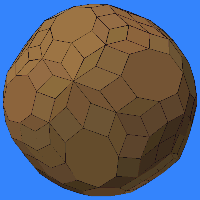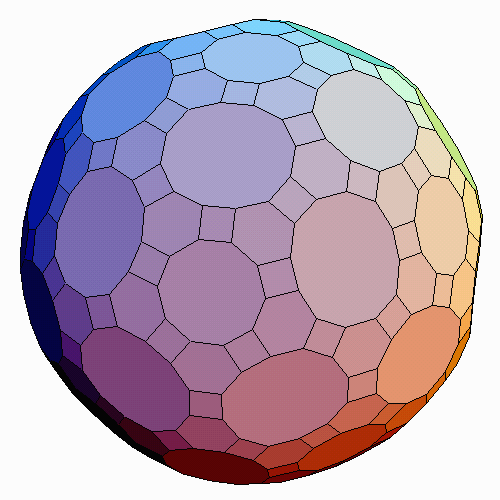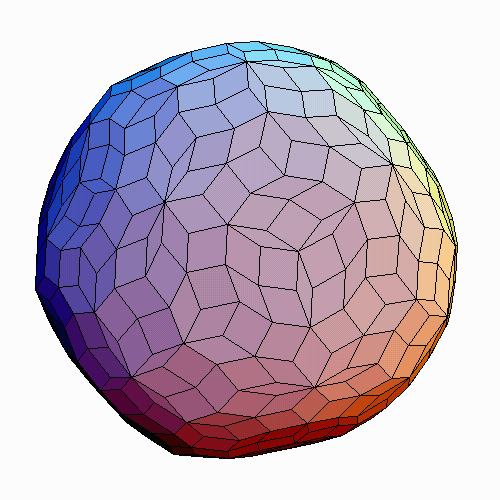Zonohedrification
One interesting thing aspect of zonohedra is that we can create new ones by a systematic process starting with any given polyhedron. There aren't too many interesting general processes which input an arbitrary polyhedron and output another polyhedron. Truncation, stellation, dualization, compounding, and zonohedrification are the main ones that I can think of.
Shown here is a 31-zone 242-sided zonohedron. Its star is the 31 axes of symmetry of the icosahedron. (It has been proposed as the basis of an architectural system --- akin to the geodesic dome, but with a wider variety of forms and a smaller inventory of parts --- by Steve Baer.) Notice it contains thirty irregular twelve-sided faces, but they are centrally symmetric; each edge is opposite an equal parallel edge. The sixty hexagons which border decagons are also slightly irregular, but the twenty hexagons on the 3-fold axes are regular.
The term for a polygon which is not necessarily regular, but opposite sides are equal and parallel, is a zonogon. The general definition of a zonohedron is a polyhedron bounded by zonogons. In the special case where the zonogons happen to be 4-sided, they are parallelegrams. (A zonotope is an n-dimensional object for which the zonogon and the zonohedron are the 2- and 3-dimensional instances.)
(Note the original 1893 definition of a zonohedron by Fedorov only required faces in which opposite edges are parallel --- not necessarily equal --- but modern usage adds the equality condition. See the paper by Jean Taylor in the references.)
Exercise: In three of the Archimedean solids, all the faces have an even number of sides. As these faces are zonogons, these three polyhedra are zonohedra by this definition. Which three ?
Answer: This, this, and this. Note that they are the truncated quasiregular polyhedra.
The vertices of a zonohedron are determined from a star of vectors in space by considering all possible ways of summing a subset of those vectors. For example, given any three edge-direction vectors, p, q, and r, the eight vertices of a parallelepiped are defined as sums of the form a p + b q + c r, where {a, b, c} is one of the eight boolean triples: {0,0,0}, {0,0,1}, {0,1,0}, {0,1,1}, {1,0,0}, {1,0,1}, {1,1,0}, {1,1,1}. (Here {0,0,0} gives a vertex at the origin and {1,1,1} gives its opposite vertex.. Use -1 in place of the 0's for coordinates of a larger zonohedron centered on the origin.) With more than three vectors, the same idea gives 2 to the n vertex coordinates, of which some are in the inside and so are not of interest. One can take the "convex hull" of the set to find just the visible vertices. For example, with four vectors, chosen as the vertices of a tetrahedron, there are sixteen defined points using a boolean {a,b,c,d}, but only fourteen are vertices visible on the outside of the rhombic dodecahedron. Points {0,0,0,0} and {1,1,1,1} lie at the center and are eliminated. Using an algorithm which does essentially this, but in a much faster manner, I have created the zonohedrifications listed below.
To see how larger zonogon faces arise, observe that if three vectors of the star lie in a plane, the three parallelegram faces flatten out into a hexagon: For example, if the star which produces the rhombic dodecahedron is adjusted so that three of the vectors are almost coplanar, the resulting zonohedron is a distorted rhombic dodecahedron, consisting of twelve rhombi which approximate a hexagonal prism. If the star is adjusted further so three vectors are exactly coplanar, the result is a hexagonal prism, because sets of parallelegrams merge into hexagons. In general, a star with k vectors in a plane produces a 2k-sided polygon in which opposite sides are equal and parallel.
 And
now for zonohedrification. The vertices of any polyhedron can be
thought of as vectors which define a star relative to the polyhedron's
center. We use that star to create the zonohedron which we call the zonohedrification
of the original polyhedron. As a result, for any two vertices of the original
polyhedron, there are two opposite planes of the zonohedrification which
each have two edges parallel to the vertex vectors. At left is the 24-zone
solid defined by the vertices of the snub
cube. Note that this zonohedrification
of the snub cube has octahedral symmetry, but is not chiral like the
snub cube. All zonohedra have central symmetry by construction, and so
are not chiral.
And
now for zonohedrification. The vertices of any polyhedron can be
thought of as vectors which define a star relative to the polyhedron's
center. We use that star to create the zonohedron which we call the zonohedrification
of the original polyhedron. As a result, for any two vertices of the original
polyhedron, there are two opposite planes of the zonohedrification which
each have two edges parallel to the vertex vectors. At left is the 24-zone
solid defined by the vertices of the snub
cube. Note that this zonohedrification
of the snub cube has octahedral symmetry, but is not chiral like the
snub cube. All zonohedra have central symmetry by construction, and so
are not chiral.
Exercise: Because there are twenty-four 8-sided zonogons in the zonohedrification shown, there must be twenty-four different planes through the center of the snub cube which each contain four vertices. Study the snub cube and find four of its vertices which lie in a common plane through its center.
Answer: These four, for example. (No other planes through the center contain more than two vertices, because all the other faces of the zonohedrification are 4-sided.)
Here is a list of zonohedrifications of the platonic and archimedean solids, categorized according to the symmetry of the starting solid. (In the tetrahedral case, the resulting zonohedra have octahedral symmetry.) Each line lists a starting polyhedron and its zonohedrification. In a few cases, the result is one of the familiar Archimedean solids pointed out in the exercise above. Some of these zonohedra correspond with photos of paper models (made by Paul Donchian) in Plate II of Coxeter's Regular Polytopes. For reference, his figure number is given here [in brackets]. All the other ones here have never been constructed before, as far as I know.
- tetrahedral symmetry
- {3,3} tetrahedron, rhombic dodecahedron [2]
- (3,6,6) truncated tetrahedron, 12 zones
- octahedral symmetry
- {3,4} octahedron, cube [1]
- {4,3} cube, rhombic dodecahedron [2]
- (3,4,3,4) cuboctahedron, 6 zone truncated octahedron [3]
- (3,8,8) truncated cube, 12 zones [9]
- (4,6,6) truncated octahedron, 12 zones [10]
- (3,4,4,4) rhombicuboctahedron, 12 zones, [11]
- (4,6,8) truncated cuboctahedron, 24 zones (illustrated below) [15]
- (3,3,3,4) snub cube, 24-zones, (illustrated above at left)
- icosahedral symmetry
- {3,5} icosahedron, 6 zone rhombic triacontahedron [4]
- {5,3} dodecahedron, 10 zone rhombic enneacontahedron [8]
- (3,5,3,5) icosidodecahedron, 15 zone truncated icosidodecahedron [13]
- (5,6,6) truncated icosahedron, 30 zones
- (3,10,10) truncated dodecahedron, 30 zones
- (3,4,5,4) rhombicosidodecahedron, 30 zones
- (4,6,10) truncated icosidodecahedron, 60 zones
- (3,3,3,5) snub dodecahedron, 60 zones

